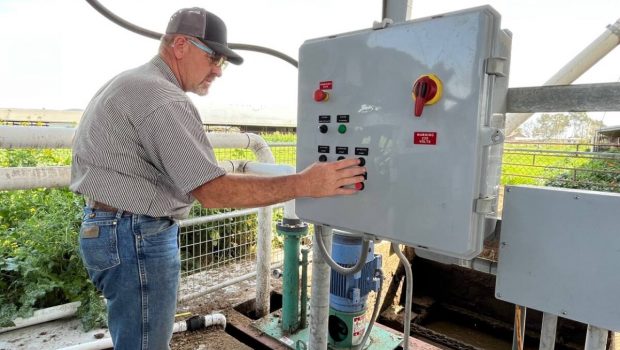Drought inspires dairy farms in Marin, Sonoma counties to employ technology
Staring at a hillside already turning a lighter shade of green while barely out of winter, Bivalve Dairy farmers John and Karen Taylor are trying to steer out of a third year of drought this spring in Marin County with the help of technology.
“This concerns me because we’re seeing drought-like conditions in February,” John Taylor said, pointing across the 705-acre organic farm near Point Reyes where they tend to 400 head of dairy cows. Of those, they milk 125 on the farm off Highway 1. “We’re doing a lot less than we used to,” he added.
Karen Taylor, a sixth-generation dairywoman, recalled how her parents, Sharon and William Bianchini, used to milk 350 cows on the West Marin farm once called the Bianchini Ranch founded in 1973.
But today, many Marin farmers like the Taylors, who have sold off 200 head of cattle, have reduced their herds to scale down the feed. And the Taylors remember how stressful it was to run out of water for a month last summer at the height of drought — not the easiest of times to run a ranch.
The Taylors took over the Marin County farm on Jan. 1, 2006, from her parents. The duo is pulling out all the stops in making their water go far.
With John Taylor tapping into his engineering degree at California Polytechnic University, San Luis Obispo, he’s able to come up with innovative measures and practices. Some have already been implemented. Others are in the wings, or rather, in the box awaiting parts delayed by supply-chain issues.
When all is said and done, the Taylors expect to save about 10,000 gallons of water per day from the changes they’re making on the farm named after a former, nearby train station meant as a water stop for the Northwestern Pacific Railroad steam engine for almost six decades.
Once all the parts arrive by May, John Taylor plans to assemble an automated control system for his new Roomba-like barn floor scraper, which collects manure rather than flushes it away with water. In turn, water from the manure could be extracted and used as compost to fertilizer the pastures.
The Taylors also utilize the cows moving across the pasture to aerate the soil, a “no-till” method endorsed by the Natural Resources Conservation District and University of California Cooperative Extension.
John Taylor is also planning to build a hay dryer to turn the coastal grasses and other plants into feed that goes farther on the farm, thus reducing the need to spend the mega dollars expected to buy hay from outside sources when the pastures become nonedible for the cows. Bales of silage, which is wet hay produced from the pasturelands, are bound, wrapped and stored in a barn. This way, the feed is ready on demand.
They’ve also built a greenhouse to grow lemna, a form of silage that’s essentially a duckweed used as a feed supplement. The Taylors said their cows like the grain, hay and plant mix, and a nutritionist monitors their rations of the “recipe” that’s found to be more digestible for the cows.
The Taylors have also adopted a complex, efficient irrigation and water storage system with $10,000 in grant funding from the Marin Agricultural Land Trust (MALT) and assistance from scientists from the Massachusetts Institute of Technology.








Gloss